| Srl | Item |
| 1 |
ID:
146787
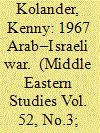

|
|
|
|
|
| Summary/Abstract |
This paper considers two aspects of historiography about the 1967 Arab–Israeli war – American and Soviet foreign policy in the region – to better appreciate the Soviet role in the outbreak of hostilities, as well as how the war concretized the USA–Israel ‘special relationship’ and weakened American–Arab relations. Relying especially on research from the Lyndon Johnson Presidential Library and Foreign Relations of the United States (FRUS), this paper argues that Soviet officials had little interest in pursuing measures to prevent war during the prewar crisis because the situation promised to undermine American interests in the region.
|
|
|
|
|
|
|
|
|
|
|
|
|
|
|
|
| 2 |
ID:
095965
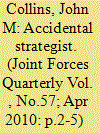

|
|
|
| 3 |
ID:
167787
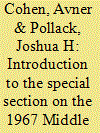

|
|
|
|
|
| Summary/Abstract |
Public understanding of the nuclear dimensions of the June 1967 Middle East War has progressed considerably since the late 1990s. Then, Israeli researchers showed that the vulnerability of Israel’s nuclear facility at Dimona to Egyptian air power played a significant role in the thinking of Israel’s military and political leaders during the crisis of May and early June. This issue’s special section offers significant new advances in addressing unresolved questions about the role of Israel’s nuclear program during these events. Did Egypt’s leaders actually have designs on Dimona, and how did their thinking about Dimona change over the course of the crisis? How close was Israel to possessing a usable nuclear device on the war’s eve? In what manner and circumstances might Israel have detonated its nuclear device? Did the US government know or suspect that Israel had an underground reprocessing plant adjacent to the Dimona reactor, enabling it to separate plutonium and build nuclear devices?
|
|
|
|
|
|
|
|
|
|
|
|
|
|
|
|
| 4 |
ID:
169448


|
|
|
|
|
| Summary/Abstract |
2017 marked the 50th anniversary of the 1967 war and of Israel’s occupation of what the European Union (EU) considers, in accordance with international law, to be Palestinian and Syrian territories. Almost as long is the involvement of the EU in the conflict, beginning with the formation of the European Political Cooperation (EPC) agreement in 1970.1 This makes the Israeli-Palestinian conflict one of the longest, sustained cases of active EU involvement in world politics. In the EU’s 2003 security strategy, resolution of the Israeli-Palestinian conflict was defined as a ‘a strategic priority for Europe’ and one of the keys for ‘dealing with other problems in the Middle East.’2
|
|
|
|
|
|
|
|
|
|
|
|
|
|
|
|
| 5 |
ID:
180234
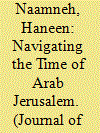

|
|
|
|
|
| Summary/Abstract |
For many Palestinians, the colonial denial of Palestinian self-determination in an independent nation-state has rendered futile the very notion of a future. But it is imperative to challenge the colonial logics that produce the native’s future as always already failed, unachievable, or impossible. This essay examines snippets of the life of Arab Jerusalem between the two major ruptures of 1948 and 1967 to deconstruct colonial and nationalist epistemologies of time and to challenge the persistently violent present and its domination of Palestinian pasts and futures. Using as its lens the memories and attachments of Jerusalemites who lived, worked, and struggled in the city, the essay examines the ways in which they thought of, imagined, produced, fulfilled, or were deprived of a future—in other words, how Jerusalemites shaped futurity. Such a nonlinear unfolding of time challenges dominant perceptions of the Nakba as constituting a clean break between past and present.
|
|
|
|
|
|
|
|
|
|
|
|
|
|
|
|
| 6 |
ID:
123609
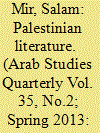

|
|
|
| 7 |
ID:
163116


|
|
|
|
|
| Summary/Abstract |
What explains the formation and division of conflict groups? What mechanisms shape the content and direction of factional alliances? This article addresses these questions by re-examining the factional politics and contentious conflicts in Guangzhou in 1967. It has long been recognised that during the Cultural Revolution there was a clear division between factions labelled as "conservative" and "radical", with the former comprised of groups that were relatively favourable to the status quo of Party authority and the latter composed of groups that were opposed to the existing rule. This interpretation, however, cannot withstand scrutiny at close range in light of the more extensive evidence available today. Focusing on the prominent case of Guangzhou, this article argues that the positions of both factions were interactive and strategic in nature. Their rivalry developed as a result of tactical manoeuvres and an ever-shifting set of interactions among local rebels, military authorities and political actors in Beijing, rather than any preexistence of rivalry or ideological differences. The discussion of the implications of a more dynamic interpretation of factional conflicts during the Cultural Revolution enhances our understanding of the contentious politics in Maoist China.
|
|
|
|
|
|
|
|
|
|
|
|
|
|
|
|
| 8 |
ID:
167855
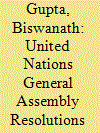

|
|
|
|
|
| Summary/Abstract |
The launch of Sputnik in 1957 followed by Explorer in 1958 showcased the potential of space and stressed the need for a robust body of law legislating space as beneficial to all states. Following the launches, a series of resolutions by the United Nations’ General Assembly developed the core principles of international space law. This article conducts an analysis of resolutions passed from 1957 to 1967 to understand the genesis of space law principles as reflected in the Outer Space Treaty of 1967. These principles include sovereign equality, peaceful purposes and international cooperation, non-appropriation of space, common heritage of mankind, environmental protection, and how to address non-governmental entities engaged in space activities.
|
|
|
|
|
|
|
|
|
|
|
|
|
|
|
|